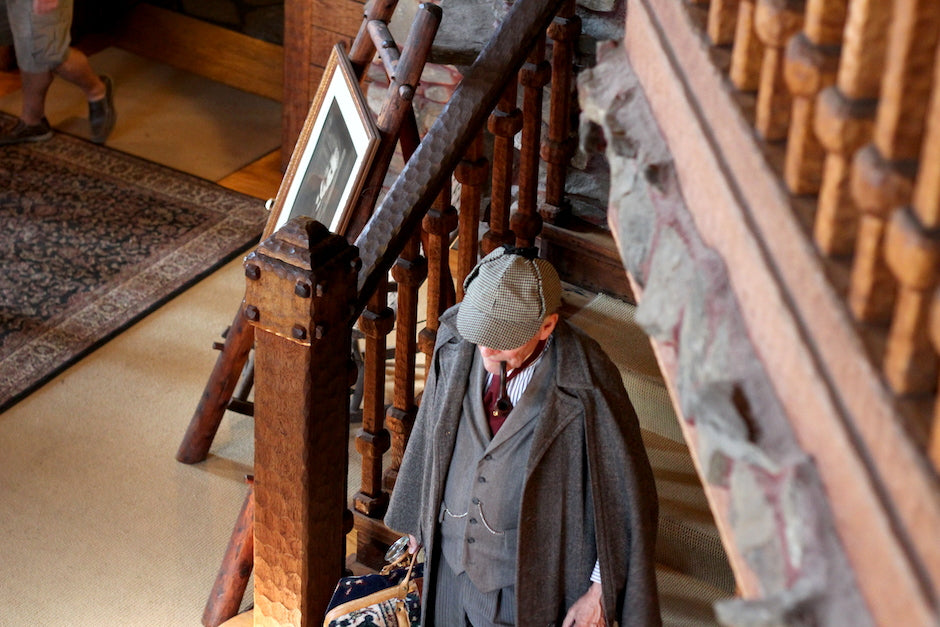Easily overlooked East Haddam is nice to look at, and it’s not that far away. The drive up I-91 North and over 66 East runs about 40 miles and under an hour without traffic. The scenic route, mostly along Route 80, tallies just about the same.
Either way—you can also take 95—puts you in a part of the state untouched by urban development, about ten miles in from the mouth of the Connecticut River. Peeking out over lush forest there, right on the border with the town of Lyme, is something out of a novel, and partially inspired by a series of them: Gillette Castle.
Once upon a time, the seminal stage actor, writer and technician William Gillette was one of Connecticut’s most famous residents. The scope of his career is nearly unparalleled. Over six decades spanning the 19th and 20th centuries, he wrote 13 plays, authored 27 books, claimed four U.S. patents for innovations in theatrical special effects and played countless roles across America.
sponsored by
Most noted of all is his portrayal of Sherlock Holmes. It turns out Gillette was instrumental in shaping the pop-culture iconography still associated with the famous fictional detective, responsible for Holmes’s now-quintessential deerstalker hat and long, sloping tobacco pipe—props Gillette chose in order to enliven the character for the stage that never appeared in creator Arthur Conan Doyle’s original works. Gillette also coined the precursor to Holmes’s eventually popular catch-phrase, “Elementary, my dear Watson,” probably one of the most recognizable lines in the English language. Between 1,300 lucrative stagings as Holmes and a long, successful career leading up to it, Gillette had plenty of money to build a luxurious East Haddam home, dubbed the “Seven Sisters Estate,” in 1914.
Now we call it Gillette Castle. Walking up to its four clifftop stories of horizontally cemented rock, overlooking forest and river, is surreal. A tower and masonic window sills give a craggy appearance to the grey giant. Against the sky, the castle looks singular and hulking. With a little imagination, one can easily see it as the setting for one of Holmes’s great adventures.
Bill Mattioli, Gillette Castle State Park supervisor and one of three year-round employees charged with the upkeep of the 206-acre tract, says Gillette would wryly refer to his home as his “pile of rocks.” Sure enough the mansion—the “castle” designation came later, after Gillette’s death—is made from fieldstones from surrounding farmland, and reflects a typical New England geology.
sponsored by
The interior is a different story. Designed by Gillette, there are special effects and a sense of play peppered throughout. The light switches, which look like wooden levers, are hollow caps for more conventional technology. A secret passageway allowed for grand, surprise entrances while a trick bar top was a source of much practical joking. Strategic mirrors aided Gillette in surveying the comings and goings of his guests and, as lore has it, soothed his fears of intruders.
Mattioli says not much has changed about the layout or decor, save “a few rugs” and other housekeeping-inspired adjustments, since its completion in 1919. The furnishings are almost entirely wooden. 47 heavy wooden doors with externally carved latches look more like beautiful Celtic knots than working locks, though they still function as they’re meant to. The third floor houses Gillette’s personal art collection, including original works by landscape artist William T. Richards. A summer staff is present to help guide visitors through the winding rooms, open between Memorial Day and Columbus Day each season.
On the grounds, visitors are treated to the protected expanse of his property. Picnic benches and tables are situated near the stone “Grand Central Station” terminal. Following a lifelong passion of his, Gillette built a quarter-sized version of railroad. As conductor, he entertained the likes of Albert Einstein and Calvin Coolidge on rides through the woods. Hikers can still enjoy the train’s bridges and tunnels as they crisscross the park.
Mattioli says that Gillette had a profound appreciation for conservation. His will states that he would lament the ownership of his property to be held in the hands of “blithering sapheads” who, presumably, would alter his mansion or sell off the land for development. For Mattioli, thinking of the trails and hills around the castle, Gillette’s “respect for the land [is] easy to understand.”
All this roving can leave you in need of refreshment. There’s a food court offering hotdogs and cold sodas, but if you’re looking for something more substantial, check out the Gelston House in downtown East Haddam. The back patio has a wonderful view of the Connecticut River, offering moderately priced bar food. Over in the dining room, you can find more expensive, upscale choices.
If thinking on Gillette the accomplished stage actor has you hungry for theater, you can time your visit to coincide with one of the Goodspeed Opera House’s performances. Next door to the Gelston House, the Goodspeed is an American Gothic treasure. Shows run from April through December, encompassing Gillette Castle’s visiting season. Over the years many productions have left its stage for one on Broadway, a point of pride among locals.
To observe that pride for yourself, all it takes is a little sleuthing up in East Haddam.
Gillette Castle
67 River Road, East Haddam (map)
10am-5pm daily, Memorial Day through Columbus Day.
(860) 526-2336
www.ctvisit.com/parks-and-forests/…
Written and photographed by Jared Emerling.










